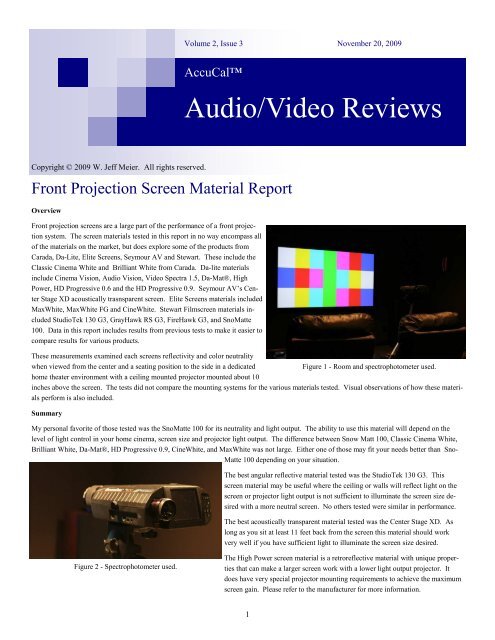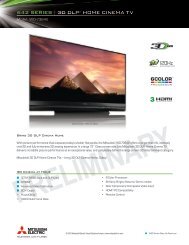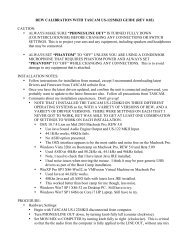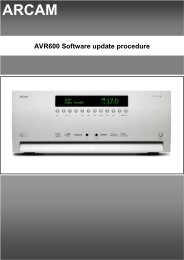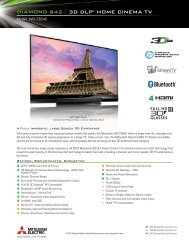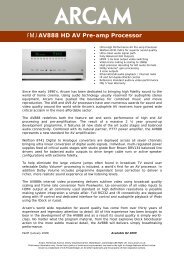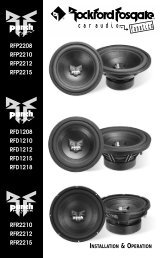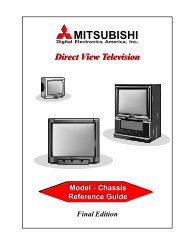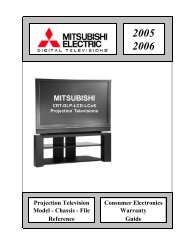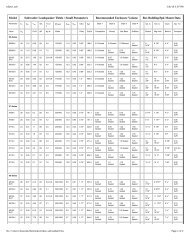AccuCal Front Projection Screen Report.pdf - Home Theater Shack
AccuCal Front Projection Screen Report.pdf - Home Theater Shack
AccuCal Front Projection Screen Report.pdf - Home Theater Shack
You also want an ePaper? Increase the reach of your titles
YUMPU automatically turns print PDFs into web optimized ePapers that Google loves.
Copyright © 2009 W. Jeff Meier. All rights reserved.<br />
<strong>Front</strong> <strong>Projection</strong> <strong>Screen</strong> Material <strong>Report</strong><br />
Overview<br />
<strong>Front</strong> projection screens are a large part of the performance of a front projection<br />
system. The screen materials tested in this report in no way encompass all<br />
of the materials on the market, but does explore some of the products from<br />
Carada, Da-Lite, Elite <strong>Screen</strong>s, Seymour AV and Stewart. These include the<br />
Classic Cinema White and Brilliant White from Carada. Da-lite materials<br />
include Cinema Vision, Audio Vision, Video Spectra 1.5, Da-Mat®, High<br />
Power, HD Progressive 0.6 and the HD Progressive 0.9. Seymour AV’s Center<br />
Stage XD acoustically trasnsparent screen. Elite <strong>Screen</strong>s materials included<br />
MaxWhite, MaxWhite FG and CineWhite. Stewart Filmscreen materials included<br />
StudioTek 130 G3, GrayHawk RS G3, FireHawk G3, and SnoMatte<br />
100. Data in this report includes results from previous tests to make it easier to<br />
compare results for various products.<br />
These measurements examined each screens reflectivity and color neutrality<br />
when viewed from the center and a seating position to the side in a dedicated<br />
Figure 1 - Room and spectrophotometer used.<br />
home theater environment with a ceiling mounted projector mounted about 10<br />
inches above the screen. The tests did not compare the mounting systems for the various materials tested. Visual observations of how these materials<br />
perform is also included.<br />
Summary<br />
My personal favorite of those tested was the SnoMatte 100 for its neutrality and light output. The ability to use this material will depend on the<br />
level of light control in your home cinema, screen size and projector light output. The difference between Snow Matt 100, Classic Cinema White,<br />
Brilliant White, Da-Mat®, HD Progressive 0.9, CineWhite, and MaxWhite was not large. Either one of those may fit your needs better than Sno-<br />
Matte 100 depending on your situation.<br />
Figure 2 - Spectrophotometer used.<br />
Volume 2, Issue 3<br />
<strong>AccuCal</strong><br />
The best angular reflective material tested was the StudioTek 130 G3. This<br />
screen material may be useful where the ceiling or walls will reflect light on the<br />
screen or projector light output is not sufficient to illuminate the screen size desired<br />
with a more neutral screen. No others tested were similar in performance.<br />
The best acoustically transparent material tested was the Center Stage XD. As<br />
long as you sit at least 11 feet back from the screen this material should work<br />
very well if you have sufficient light to illuminate the screen size desired.<br />
The High Power screen material is a retroreflective material with unique properties<br />
that can make a larger screen work with a lower light output projector. It<br />
does have very special projector mounting requirements to achieve the maximum<br />
screen gain. Please refer to the manufacturer for more information.<br />
1<br />
November 20, 2009<br />
Audio/Video Reviews
<strong>AccuCal</strong><br />
Measured Test Results<br />
The following table shows the results of a series of measurements for the tested screen materials.<br />
Material 0° Gain 18°Gain 0° Max x 0° Max y 18° Max x<br />
2<br />
18° Max y 0° Avg x<br />
0° Avg y 18° Avg x<br />
18° Avg y<br />
Classic Cinema White 0.97 0.95 0.001 0.003 0.001 0.003 0.000 0.002 0.000 0.002<br />
Brilliant White 1.03 1.01 0.004 0.003 0.002 0.003 0.002 0.002 0.001 0.001<br />
Da-Mat® 1.09 1.00<br />
0.002 0.001 0.002 0.003 0.001 0.001 0.001 0.002<br />
HD Progressive 0.9 0.98 0.95 0.003 0.002 0.003 0.002 0.001 0.001 0.001 0.001<br />
HD Progressive 0.6 0.72 0.70 0.003 0.002 0.003 0.001 0.001 0.001 0.001 0.001<br />
Cinema Vision 1.04 0.95 0.005 0.008 0.008 0.010 0.002 0.004 0.003 0.004<br />
Video Spectra 1.5 1.27 1.15 0.002 0.003 0.002 0.007 0.001 0.001 0.001 0.004<br />
High Power 1.82 0.96 0.002 0.006 0.009 0.012 0.001 0.003 0.004 0.005<br />
SnoMatte 100 1.02 1.00<br />
0.001 0.003 .0.002 0.002 0.000 0.001 0.000 0.001<br />
StudioTek G3 1.27 1.19 0.002 0.003 0.003 0.004 0.001 0.001 0.001 0.002<br />
FireHawk G3 0.90 0.75 0.007 0.005 0.008 0.006 0.003 0.002 0.004 0.002<br />
GrayHawk RS G3 0.88 0.71 0.002 0.002 0.003 0.004 0.001 0.001 0.002 0.002<br />
MaxWhite 1.03 0.99 0.003 0.004 0.002 0.005 0.001 0.002 0.001 0.002<br />
MaxWhite FG 1.04 1.02 0.003 0.003 0.004 0.002 0.001 0.001 0.001 0.001<br />
CineWhite 0.99 0.97 0.004 0.004 0.005 0.003 0.002 0.002 0.002 0.002<br />
Center Stage XD (AT) 0.94 0.93 0.002 0.004 0.003 0.004 0.001 0.002 0.001 0.002<br />
Audio Vision (AT) 1.05 0.96<br />
0° - Measurements at this angle are perpendicular to<br />
the screen<br />
18° - Measurements at this angle were taken 18 degrees<br />
to the side and 6 degrees down, but are of the<br />
same location as the 0 degree point on the screen<br />
0.002 0.001 0.002 0.003 0.001 0.001 0.001 0.002<br />
Gain - Average of 10 colors ratio of light at the observer<br />
to light sent to the screen.<br />
Max. x or y - Maximum absolute change in CIE<br />
color measured as caused by the screen for the 10<br />
colors measured<br />
Avg x or y - Average absolute change in CIE color<br />
measured as caused by the screen for the 10 colors<br />
measured<br />
(AT) - Acoustically transparent material
<strong>AccuCal</strong><br />
<strong>Screen</strong> Material Observations And Comments<br />
Classic Cinema White - This material was very color neutral. It does have a slight amount of texture, but this was not visible at a 9’ viewing distance.<br />
It did not appear to lend much character to the image which is a good thing. It has a very slight sheen compared to a piece of paper, but I did<br />
not notice it in real images. This is the closest alternative to SnoMatte 100.<br />
Brilliant White - This material was mostly color neutral. It does have a slight amount of texture, but this was not visible at a 9’ viewing distance. It<br />
has a very slight sheen compared to a piece of paper, but I did not notice it in real images.<br />
Da-Mat® - This material was very color neutral. It does have a little more texture than the Classic Cinema White, but this was not visible at a 9’<br />
viewing distance. It had a slight sheen to it which was visible on images infrequently.<br />
HD Progressive 0.9 - This material is very color neutral. It appeared to be a very smooth surface.. It also has a very slight sheen to it which was<br />
visible on images infrequently. This may explain its gray coloring and yet a gain very nearly 1.0. It did not add much character to the image. This<br />
material is designed to aid with rejecting light from reflections and may help in that situation.<br />
HD Progressive 0.6 - This material is very color neutral. It appeared to be a very smooth surface. It also has a very slight sheen to it which was<br />
visible on images infrequently. The sheen on this was stronger than the HD Progressive 0.9 sample. This material would require much more light<br />
to illuminate the same screen size than any other sample tested here. A product like this is for special circumstances and would not fit most peoples<br />
requirements.<br />
Cinema Vision - This material is not as color neutral as one would like. It does have a slight amount of texture, but this was not visible at a 9’<br />
viewing distance. The color shifts induced by this material were strong enough to bother some people. This material did add character to the image<br />
that was distracting compared to the other samples. The sheen on this product was visible on brighter images. The gain of this material was not<br />
high enough to justify its use. The negatives of this product did not offset its positive attributes and is not one I would recommend.<br />
Video Spectra 1.5 - This material was mostly color neutral. The surface was patterned on this product. The color shifts induced by this material<br />
would not be strong enough to bother most people. This material did add character to the image that was very distracting compared to the other<br />
samples. The sheen on this product was obvious on brighter images. The gain of this material would aid in increasing the image brightness for<br />
projectors with lower light output than the screen size desired. This was the most objectionable material of those tested for home theater use and is<br />
not one I would recommend.<br />
High Power - This material was the least color neutral of those tested. It appeared to be a very smooth surface. The color shifts induced by this<br />
material may be strong enough to bother some people. This is a retroreflective material that works best when the projector is mounted near the<br />
viewers head. The ceiling mounting in this theater is more common and shows the reduction in performance from this orientation. This product did<br />
contain some sparkling elements that are visible when viewed at closer distances. The gain of this material would aid in increasing the image<br />
brightness for projectors with lower light output than the screen size desired.<br />
SnoMatte 100- This material was very color neutral. It appeared to have a very smooth surface. It had no surface sheen or sparkling elements.<br />
This material is exceptional at extreme viewing angles. This is the best material tested for a neutral screen material.<br />
StudioTek 130 G3 - This material was very color neutral. It appeared to have a very smooth surface. It had many sparkling elements to increase the<br />
screen gain. The shimmering caused by these elements was visible in brighter elements of images. The gain of this material would aid in increasing<br />
the image brightness for projectors with lower light output than the screen size desired. Off axis gain was also good. This was the best sample<br />
tested of an angular reflective material for increasing screen gain.<br />
FireHawk G3 - This material is not as color neutral as one would like. It appeared to have a very smooth surface. It also had many sparkling elements<br />
to increase the screen gain. The shimmering caused by these elements was visible at moderate light levels with images. The actual gain of<br />
this material was not high enough to offset the light lost by the dark gray tint. This material is intended to aid in rooms with significant scattered<br />
light from walls and ceilings. It is a special use material that should be considered with care.<br />
GrayHawk RS G3 - This material was very color neutral. It appeared to have a very smooth surface. It also had many sparkling elements to increase<br />
the screen gain. The shimmering caused by these elements was visible at moderate light levels with images, but a little less than the Fire-<br />
Hawk material. The actual gain of this material was not high enough to offset the light lost by the dark gray tint. This material is intended to aid in<br />
rooms with significant scattered light from walls and ceilings. It is a special use material that should be considered with care.<br />
3
<strong>AccuCal</strong><br />
<strong>Screen</strong> Material Observations And Comments Continued<br />
MaxWhite & MaxWhite FG- These materials were very color neutral. It does have a some texture. This was slightly visible at a 9’ viewing distance.<br />
This material also has some sheen that is visible on bright images.<br />
CineWhite - This material was reasonably color neutral. It does have a slight amount of texture, but this was not visible at a 9’ viewing distance. It<br />
did not appear to lend much character to the image which is a good thing. This material also has some slight sheen, but I did not notice it on images.<br />
Acoustically Transparent <strong>Screen</strong> Material Observations And Comments<br />
Center Stage XD - This material was mostly color neutral. It does have a strong texture from the weave used to pass the audio through the screen.<br />
At 9’ it was slightly visible. This material would be best for eleven foot or greater viewing distance. At eleven feet this material looked very good.<br />
Treble was 2 db down at 20 kHz compared to the level at 2 kHz. The black backing added another 1 db loss at 20 kHz. The audio response effect<br />
was a relatively smooth loss from 3kHz to 20kHz. I would consider equalizing this out of the system if the boost can be kept at or below 3 db if<br />
you listen near reference. Blown tweeters are the most common equipment failure that I find. Care should be taken to understand the system capabilities<br />
before boosting the treble level.<br />
Audio Vision - This material was very color neutral. It does have a little more texture than the Classic Cinema White and an obvious hole pattern.<br />
The hole pattern was visible up to 15 feet. It had a slight sheen to it which was visible on images infrequently at 9 feet. Treble was 6 db down at 20<br />
kHz compared to the level at 2 kHz. The audio response effect was a relatively smooth loss from 4kHz to 20kHz. This level of loss may be problematic<br />
to equalize out. If equalization requires more than 3 db boost it could jeopardize the tweeter if you listen near reference. Blown tweeters<br />
are the most common equipment failure that I find. Care should be taken to understand the system capabilities before boosting the treble level.<br />
How To Use These Results<br />
These measurements and observations may help you understand what can affect screen performance and help you judge how well the screen will<br />
perform for home theater use. Please refer to the manufacturer for more information on these products. You should always obtain a screen sample<br />
before ordering a screen to see if it fits your needs. It is best to use the sample in your theater after the room is setup except for the screen. The<br />
projector your choose, the projector mounting, screen size, screen position, distance from the screen along with the viewing angles in your situation<br />
will determine how well the screen performs for you. The gains observed in this report are going to match a ceiling mounted projector system best.<br />
<strong>Screen</strong>s with gain may perform better than that observed if the projector is mounted closer to the observers eye level.<br />
The closer your viewing position is to the screen the more problems you will have with its texture, sheen and sparkling elements. At 14 feet or<br />
more only the sparkling elements, color problems and gain are likely to be visible. At less than 10 feet you need to be very careful about material<br />
selection to avoid seeing artifacts caused by texture and sheen.<br />
Acoustically transparent materials are more complex and can induce interference patterns (moiré) depending on the system. These materials should<br />
be installed very carefully with consideration to both the audio and video performance.<br />
4
Test Conditions<br />
<strong>AccuCal</strong><br />
This room had no windows, dark walls, equipment rack was in the hall not facing screen and minimal light sources were present in the room. All<br />
room lighting was off at the time of the tests. The most significant light source was a PC that was dimmed, in the back of the room and facing the<br />
rear of the room. Background light sources with the projector off were measured to add 0.000073 fL to the Carada Classic Cinema White screen.<br />
All color and screen luminance measurements were made with the PR-670 carefully positioned and tripod mounted to measure an area that was<br />
projected as a target from the projector. This was true for both luminance and illuminance measurements. The same measurement series taken at<br />
the beginning of the test was also repeated at the end to help ensure that nothing had drifted significantly.<br />
The Carada Classic Cinema White screen used in these tests is the screen installed in this theater. All other screen materials in these tests were<br />
samples from Da-Lite. <strong>Screen</strong> gain measurements could be influenced by the screen samples not being tensioned like the Carada. Multiple attempts<br />
were made to position the sample to keep the sample flat in the area being measured. All screen samples were taped to the Carada screen for<br />
measurement. Only one screen sample was used for each screen material tested. None of the samples appeared to be damaged.<br />
The projector in this case was ceiling mounted in the center of the screen horizontally and vertically above the screen. Maximum vertical shift was<br />
used in this product. The projector was also warmed up for 2 hours before color measurements were taken to stabilize the output colors as much as<br />
possible. The spot measured was 32.5” lower than the projector’s center of projection. The projector was also on high lamp mode and the image<br />
sized for an 86” diagonal 16:9 screen near the minimum throw of the projector. This provided a bright image to maximize the signal to noise ratio<br />
of the measurements.<br />
The test patterns used to measure light output and color were all created by an Accupel HDG-4000. The patterns used were window patterns to<br />
minimize the scattered light sent to the walls, floor and ceiling. The colors measured included red, green, blue, yellow, magenta, cyan, desaturated<br />
blue, desaturated green, desaturated red and white.<br />
The PR-670 was set to measure a 1 degree field of view and extended range with the smart dark feature off. The PR-670 was AC powered during<br />
these tests. Actual screen light levels measured between 0.4 fL and 16.5 fL. At no time did the PR-670 report a value as being out of range. Nominally<br />
the light levels ranged between 1 fL and 10 fL The MS-75 lens attachment was used to measure the screen and a CR-670 cosine corrector<br />
was used to measure the light from the projector directly.<br />
<strong>Screen</strong> material observations were made in normal room lighting and with light from the projector. <strong>Screen</strong> observations included test patterns and a<br />
variety of movie material. Observations of movie images were made at 9’ at 18 degrees off center and sitting at the center of the screen with an 86”<br />
diagonal image and a maximum light level of 15 fL from the Classic Cinema White screen.<br />
No measurements were attempted to measure hot spotting because these problems can vary with the projector, but screens with more gain tend to<br />
have more issues with luminance varying with the location of the image on the screen. Retroreflectors like the High Power tend to have fewer<br />
problems with this than other high gain options.<br />
Audio was measured with an ACO Pacific MK224PH Class I microphone and Sencore SP495 preamp at 1/24 octave. The microphone was positioned 24 inches<br />
from the tweeter and on axis with it. The screen material was 3 inches from the tweeter. Wideband pink noise was measured with and without the material in the<br />
sound path and the difference was taken using TrueRTA. Strong problems with comb filtering were observed when the material was positioned very<br />
close to the speaker which is not recommended by the manufacturer. This caused an additional 6db variation from 5 to 20 kHz. A Class 1 microphone<br />
was used to reduce the interaction with the room at these frequencies. The background noise was NCB 19.<br />
5
<strong>AccuCal</strong><br />
Manufacturers Websites:<br />
Carada www.carada.com<br />
Da-Lite www.dalite.com<br />
Elite <strong>Screen</strong>s www.elitescreens.com<br />
SeymourAV www.seymourav.com<br />
Stewart www.stewartfilmscreen.com<br />
Equipment Associated With Review:<br />
HDTV Generator: Accupel HDG-4000<br />
Light & Color Measurement: Photo Research PR-670<br />
Low Light Measurement: Custom low light instrument<br />
Microphone: ACO Pacific MK224PH<br />
Microphone Preamp: Sencore SP495<br />
Phone: 832-659-1823<br />
E-mail: jeff@accucalhd.com<br />
Four Seasons, MO<br />
Audio/Video Calibration And<br />
Consulting Services<br />
Our Mission<br />
Is to deliver exceptional service and quality with respect to audio and video calibration,<br />
design and consulting for your home theater or business. We are home theater enthusiasts<br />
just like you and would like to bring to your home the best experience for you. We<br />
promise to do our best to provide you with a superior level of performance from your<br />
equipment.<br />
6<br />
Projector: JVC DLA-RS20<br />
BD Player: Sony PS3<br />
Receiver: Yamaha RX-V4600<br />
Speaker: Hales Revelation 3<br />
Video Test Material: Various Movie Trailers<br />
Audio Test Material: Avia Wideband Pink Noise<br />
<strong>AccuCal</strong> is the property of W. Jeff Meier. All other trademarks are<br />
the property of others.


